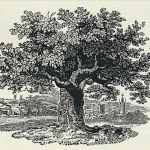part eight of The Route Not Taken
Proceeding along the proposed railroad route, we come to the village of Sandbrook. If the rail line had been laid out as planned it might have changed the village significantly.
These articles are focused on the Sutton families in southern Hunterdon County. You can find the Sutton Family Tree here: https://goodspeedhistories.com/sutton-family-tree/
part eight of The Route Not Taken
Proceeding along the proposed railroad route, we come to the village of Sandbrook. If the rail line had been laid out as planned it might have changed the village significantly.
The following article by Egbert T. Bush describes an old farm with a distillery located near Sandbrook. The village of Sandbrook is located in what was once the Haddon Proprietary Tract. Just east of the Haddon Tract was the Cook Proprietary Tract, and that is where the distillery farm was located.
 Jonas Sutton, the first of that surname to settle in Amwell Township, was married twice. His first wife’s name is not known, but she had five children. His second wife, Elizabeth Runyon, appears to have been related to the Runyon family of Franklin Township. They came to Hunterdon from Piscataway at an early date. Elizabeth also had five children, making ten in all. Because my focus is on Hunterdon County, I am missing information on many of the Suttons who lived elsewhere. Feel free to contribute information, or suggest corrections, in the comments section.
Jonas Sutton, the first of that surname to settle in Amwell Township, was married twice. His first wife’s name is not known, but she had five children. His second wife, Elizabeth Runyon, appears to have been related to the Runyon family of Franklin Township. They came to Hunterdon from Piscataway at an early date. Elizabeth also had five children, making ten in all. Because my focus is on Hunterdon County, I am missing information on many of the Suttons who lived elsewhere. Feel free to contribute information, or suggest corrections, in the comments section.
The Hammond Maps of Hunterdon County proprietary tracts are a wonderful resource for county historians. Many of the property owners shown on these maps drawn by D. Stanton Hammond in 1963 were the first Europeans to claim title to this part of the state of New Jersey. What happened to those properties in succeeding years has always fascinated me and provided wonderful material for my articles.
For the final installment of my study of the Haddon Tract,1 I am turning to the remainder of the property that was left to Nicholas Sine. As a reminder, Nicholas Signe/Sayn/Sine was a partner with another German immigrant, Jacob Sniter, in the 1748 purchase of 1300 acres of the Haddon Tract, a 2,000-acre plot that was surveyed for John Haddon in 1711. Daniel Robins had purchased the other 700 acres.
There are three ways to write about the graves in a cemetery. First, a straight alphabetical list; second, chronologically by when people died, perhaps linked to who owned the cemetery at the time; and third, by the layout of the graves.
The following is the keynote speech I delivered on September 19, 2015 for the 2nd Annual Cemetery Seminar, sponsored by the Hunterdon Co. Historical Society and others. It is somewhat modified to make it more readable, less like a speech.
My original intention was to publish an article by Jonathan M. Hoppock on the history of the Baptist Church in Locktown. And that is what I will do here, but after reading his article, I discovered that some of the ministers he listed had troubled careers, and that, of course, makes them interesting. But first, here is Mr. Hoppock’s history of the Church.
Back in February, I published an article on the cemetery connected with the Locktown Baptist church. Previously I have written about the Baptist congregation here as well as the Locktown Christian Church and its Cemetery. It seems appropriate now to include Mr. Bush’s own history of this neighborhood, which was published in the Hunterdon Democrat, on May 22, 1930. Along with the churches, Mr. Bush discusses the school house, the distillery and the Locktown Hotel, which began its life as a humble tavern, and also some of the old families, like the Chamberlins, Heaths, Lairs, Rittenhouses, Smiths and Suttons. Photographs in this article were provided by Paul Kurzenberger.
There has been a Baptist Church in Locktown since the early 19th century, and a cemetery associated with it. The church and the cemetery were located on land belonging to Daniel Rittenhouse, whose home was a short distance west of Locktown on the Kingwood-Locktown Road. Most of the names in this cemetery are of families that lived nearby in Kingwood and Delaware Townships, many of them descendants of original German immigrants. Many of the original stones are now missing, even ones that were inventoried in the 1940s. Old cemeteries are hard to preserve.